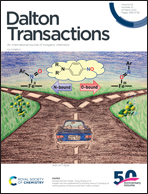Enhancing the Am3+/Cm3+ separation ability by weakening the binding affinity of N donor atoms: a comparative theoretical study of N, O combined extractants†
Abstract
Mutual separation of trivalent americium (Am3+) and curium (Cm3+) ions through liquid–liquid extraction is challenging due to the similarity in their chemical properties. Three N, O combined extractants 2,6-pyridinedicarboxylic acid di(N-ethyl-4-fluoroanilide) (Et(pFPh)DPA), diphenyl(2-pyridyl)phosphine oxide (Ph2PyPO), and alkyldiamide amine with 2-ethylhexylalkyl chains (ADAAM(EH)) have been identified to exhibit selectivity for Am3+ over Cm3+. In this work, the structures, bonding nature, and thermodynamic behaviors of a series of representative Am- and Cm-complexes with these ligands have been systematically investigated using density functional theory (DFT) calculations. Based on our calculations, the ONO angle formed by three donor atoms of the ligand in the Am-complex is slightly larger than that in its Cm-analogue. The studied ligands show their preference toward Am3+ by opening their “mouths” slightly wider. According to the Mayer bond order and the quantum theory of atoms in molecules (QTAIM) analyses, the interactions between the O donor atoms of these ligands and Am3+ and Cm3+ ions show some weak partial covalent character, and compared to the Am–O bond, there is relatively more covalency in the Cm–O bond in the corresponding complex. However, opposite results can be found in the Am–N and Cm–N bonding for the first two ligands. Particularly, for the better separation ligand ADAAM(EH), the Am–N and Cm–N interactions are extremely weak and no covalent character exists in the bonding. Nevertheless, the difference between the very weak Am–N and Cm–N interactions still leads to a better performance of ADAAM(EH). Based on the comparison of these ligands, we can find that weakening the binding ability of N atoms in the ligand may increase the difference between the Am–N and Cm–N interactions, thus enhancing the Am3+/Cm3+ separation ability of the ligand. Our study might provide new insights into understanding the selectivity of these three N, O combined ligands toward minor actinides and pave the way for designing efficient Am3+/Cm3+ extraction and separation ligands.



 Please wait while we load your content...
Please wait while we load your content...